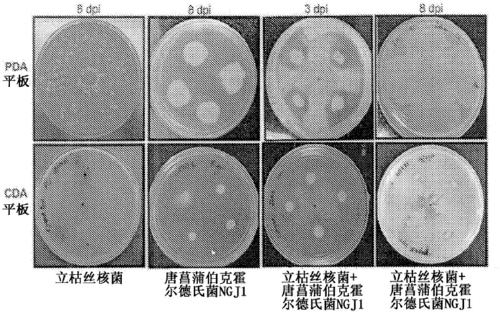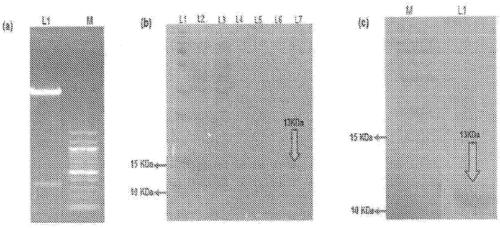Novel protein against fungal pathogens
一种蛋白质、抗真菌的技术,应用在肽/蛋白质成分、抗体医疗成分、细菌肽等方向
- Summary
- Abstract
- Description
- Claims
- Application Information
AI Technical Summary
Problems solved by technology
Method used
Image
Examples
Embodiment 1
[0068] Example 1: Identification of proteins involved in the antifungal and bacteriophagous activity of Burkholderia gladiolus strain NGJ1
[0069] This example provides the identification of Burkholderia gladiolus strain NGJ1 derived from healthy rice seedlings (as described by Jha et al 2015) as a potent antifungal and bacteriophagous bacterium. Initially, up to 3 dpi (days after incubation), the bacteria showed antifungal activity and prevented the growth of fungi in their vicinity. During the 8dpi of the confrontation (days after incubation), the bacteria started to feed on the fungus and displayed fungal-eating activity (e.g. figure 1 shown). Interestingly, on the minimal medium CDA (Czapek Dox agar) plates, the bacteriophagy behavior (spread of bacteria on fungi and degradation of fungal mycelia) was very prolific.
[0070] The inventors have discovered that some proteins of Burkholderia gladiolus strain NGJ1 have potential host-targeting signals and have further chara...
Embodiment 2
[0082] Example 2: Overexpression and purification of potential antifungal proteins
[0083] PCR amplification from Burkholderia gladiolus strain NGJ1 genomic DNA using gene-specific forward primer with SEQ ID No. 3 and reverse primer with SEQ ID No. 4 as disclosed in Table 2 The complete CDS of the Bg_9562 gene (333bp), and was further cloned into the pET28a bacterial expression vector (Novagen / Merck Life Science Private Limited) to obtain pET28a-9562 (eg figure 2 shown in a). Restriction sites for NdeI and HindIII have been added to the forward and reverse primer sequences, respectively.
[0084] After sequence verification, pET28a-9562 was transformed into E. coli (BL21 strain, DE3-codon+) to produce recombinant protein. protein Ni 2+ - Purify protein by NTA-agarose chromatography and analyze on SDS PAGE (eg figure 2 shown in b). It was further electroblotted onto a polyvinylidene fluoride (PVDF) membrane and probed with a mouse polyclonal antibody raised against an ant...
Embodiment 3
[0088] Example 3: Evaluation of Antifungal Activity of Purified Proteins
[0089] The antifungal activity of the protein having SEQ ID No. 2 was determined by treating the sclerotia of R. solani strain BRS1 with different concentrations (5, 10 and 15 μl / ml) of the purified protein. As controls, three different solutions were used—10 mM phosphate-buffered saline (PBS) pH 7.4, 50 mM wash solution (a component used in protein elution), and heat-inactivated Bg_9562 protein (by incubating in boiling water for 40 minutes) to process the sclerotia. After the treatment, the sclerotia were placed on a PDA (HIMEDIA, India) plate and incubated at 28°C for further growth. Results (such as image 3 Shown in a) In summary, 15 μg / ml of protein effectively prevents the growth of R. solani, while appropriate fungal growth is observed in the case of different controls. Inhibition of fungal growth by eBg_9562 protein treatment is summarized in image 3 b. The eBg_9562-treated sclerotia fail...
PUM
 Login to View More
Login to View More Abstract
Description
Claims
Application Information
 Login to View More
Login to View More - R&D
- Intellectual Property
- Life Sciences
- Materials
- Tech Scout
- Unparalleled Data Quality
- Higher Quality Content
- 60% Fewer Hallucinations
Browse by: Latest US Patents, China's latest patents, Technical Efficacy Thesaurus, Application Domain, Technology Topic, Popular Technical Reports.
© 2025 PatSnap. All rights reserved.Legal|Privacy policy|Modern Slavery Act Transparency Statement|Sitemap|About US| Contact US: help@patsnap.com



